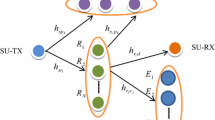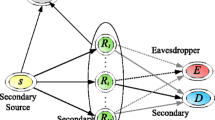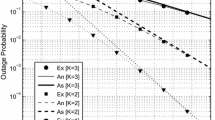Abstract
In this paper, we consider cognitive relay networks with Nth best relay and beamforming schemes under the joint impact of imperfect spectrum sensing and outdated channel feedback. Specifically, we examine the secrecy performance by deriving the exact and asymptotic analytical expressions for the secrecy outage probability. Based on the analysis, we observe that these two types of channel impairments, i.e., imperfect spectrum sensing and outdated channel feedback, greatly affect the system performance. Particularly, the outdated channel feedback (i.e., the outdated coefficient \(\rho\,<\,1\)) reduces the secrecy outage diversity gain of the two schemes, i.e., Nth best relay and beamforming, to one regardless of the number of relays. Our proposed analysis provides a helpful guideline for security system designers to cope with the unpleasant channel impairments.








Similar content being viewed by others
References
Zhao, Q., & Sadler, B. M. (2007). A survey of dynamic spectrum access. IEEE Signal Processing Magazine, 24(3), 79–89.
Goldsmith, A., Jafar, S. A., Maric, I., & Srinivasa, S. (2009). Breaking spectrum gridlock with cognitive radios: An information theoretic perspective. Proceedings of the IEEE, 97(5), 894–914.
Mitola, J., & Maguire, G. Q. (1999). Cognitive radio: Making software radio more personal. IEEE Personal Communications, 6(4), 13–18.
Cabric, D., Mishra, S. M., & Brodersen, R. W., (2004). Implementation issues in spectrum sensing for cognitive radios. In Proceeding of Asilomar conference on signals, systems, and computers (pp. 772–776).
Wu, Q., Ding, G., Wang, J., & Yao, Y. (2013). Spatial-temporal opportunity detection for spectrum-heterogeneous cognitive radio networks: Two-dimensional sensing. IEEE Transactions on Wireless Communications, 12(2), 516–526.
Zou, Y., Zhu, J., & Zheng, B. (2014). Outage analysis of multi-relay selection for cognitive radio with imperfect spectrum sensing. In Proceeding of the 2nd IEEE global conference on signal and information processing (pp. 1–5).
Dong, L., Han, Z., Petropulu, A. P., & Poor, H. V. (2010). Improving wireless physical layer security via cooperating relays. IEEE Transactions on Signal Processing, 58(3), 1875–1888.
Huang, J., Mukherjee, A., & Swindlehurst, A. L. (2013). Secure communication via an untrusted non-regenerative relay in fading channels. IEEE Transactions on Signal Processing, 61(10), 2536–2550.
Fan, L., Lei, X., Duong, T. Q., Elkashlan, M., & Karagiannidis, G. K. (2014). Secure multiuser communications in multiple amplify-and-forward relay networks. IEEE Transactions on Wireless Communications, 62(9), 3299–3310.
Li, Q., Yang, Y., Ma, W., Lin, M., Ge, J., & Lin, J. (2015). Robust cooperative beamforming and artificial noise design for physical-layer secrecy in AF multi-antenna multi-relay networks. IEEE Transactions on Signal Processing, 63(1), 206–220.
Shu, Z., Qian, Y., & Ci, S. (2013). On physical layer security for cognitive radio networks. IEEE Network, 7(3), 28–33.
Pei, Y., Liang, Y.-C., Teh, K. C., & Li, K. H. (2011). Secure communication in multiantenna cognitive radio networks with imperfect channel state information. IEEE Transactions on Signal Processing, 59(4), 1683–1693.
Zou, Y., Wang, X., & Shen, W. (2013). Physical-layer security with multiuser scheduling in cognitive radio networks. IEEE Transactions on Wireless Communications, 61(12), 5103–5113.
Liu, Y., Wang, L., Duy, T. T., Elkashlan, M., & Duong, T. Q. (2015). Relay selection for security enhancement in cognitive relay networks. IEEE Wireless Communications Letters, 4(1), 46–49.
Sibomana, L., Zepernick, H., & Tran, H. (2014). On physical layer security for reactive DF cognitive relay networks. In IEEE global communications conference, Austin, USA.
Zhu, J. (2013). Security-reliability trade-off for cognitive radio networks in the presence of eavesdropping attack. EURASIP Journal on Advances in Signal Processing, 169, 1–10.
Zou, Y., Champagne, B., Zhu, W., & Hanzo, L. (2014). Relay-selection improves the security–reliability trade-off in cognitive radio systems. arXiv:1411.0228v1
Duy, T. T., & Kong, H. Y. (2013). Performance analysis of incremental amplify-and-forward relaying protocols with Nth best partial relay selection under interference constraint. Wireless Personal Communications, 71(4), 2741–2757.
Zhang, X., Yan, Z., Gao, Y., & Wang, W. (2013). On the study of outage performance for cognitive relay networks (CRN) with the Nth best-relay selection in Rayleigh-fading channels. IEEE Wireless Communications Letters, 2(1), 110–113.
Vicario, J. L., Bel, A., Lopez-Salcedo, J. A., & Seco, G. (2009). Opportunistic relay selection with outdated CSI: Outage probability and diversity analysis. IEEE Transactions on Wireless Communications, 8(6), 2872–2876.
Barros, J., & Rodrigues, M. (2006). Secrecy capacity of wireless channels. In Proceeding of IEEE international symposium on information theory (ISIT) (pp. 356–360). Seattle, USA.
Vaughan, R. J., & Venables, W. N. (1972). Permanent expressions for order statistics densities. Journal of the Royal Statistical Society Series B, 34(2), 308–310.
Exton, H. (1976). Multiple hypergeometric functions and applications. New York: Wiley Press.
Gradshteyn, I., & Ryzhik, I. (2007). Table of integrals, series, and products (7th ed.). New York: Academic Press Inc.
Huang, Y., Al-Qahtani, F., Zhong, C., Wu, Q., Wang, J., & Alnuweiri, H. (2014). Performance analysis of multiuser multiple antenna relaying networks with co-channel interference and feedback delay. IEEE Transactions on Wireless Communications, 62(1), 59–73.
Ma, Y., Zhang, D., Leith, A., & Wang, Z. (2009). Error performance of transmit beamforming with delayed and limited feedback. IEEE Transactions on Wireless Communications, 8(3), 1164–1170.
Cai, Y., Guan, X., & Yang, W. (2014). Secure transmission design and performance analysis for cooperation exploring outdated CSI. IEEE Communications Letters, 18(9), 1637–1640.
Zou, Y., Wang, X., & Shen, W. (2013). Optimal relay selection for physical-layer security in cooperative wireless networks. IEEE Journal on Selected Areas in Communications, 31(10), 2099–2111.
Zou, Y., Wang, X., Shen, W., & Hanzo, L. (2014). Security versus reliability analysis of opportunistic relaying. IEEE Transactions on Vehicular Technology, 63(6), 2653–2661.
Acknowledgments
This work was supported by Shandong Provincial Natural Science Foundation of China (ZR2010FM011, ZR2014FQ012), the National Science and Technology Pillar Program of China during the 12th Five-Year Plan Period (2014BAK12B06), and Vietnam National Foundation for Science and Technology Development (NAFOSTED) under Grant No. 102.04-2013.13.
Author information
Authors and Affiliations
Corresponding author
Appendices
Appendix 1: Proof of Theorem 1
With assumption \(K=|{\mathbb {D}}_{{K_c}}|\), based on (2), (12) and (13), \(P_{SO1}\) in (20) is expressed as
According to (30), \(\phi _{K}(\gamma _{th1})\) is obtained as follows.
\(P_{SOA}^{N}=1\) in (48) when \(K<N\). Otherwise, \(P_{SOA}^{N}\) is derived as
By substituting (50) into (48), \(P_{SO1}^{N}\) is obtained as
\(P_{SO2}\) in (20) is different from \(P_{SO1}\) for the reason that the failure of spectrum sensing will introduce the interference from active PUs to the secondary network, i.e., \(\alpha =1\), so \(P_{SO2}\) is expressed as
where \(Z_N=\frac{\gamma _{{\mathsf {R}}_{N}{\mathsf {D}}}}{1+\gamma _{{\mathsf {P}}{\mathsf {D}}}}\), \(Y_N=\frac{\gamma _{{\mathsf {R}}_{N}{\mathsf {E}}}}{1+\gamma _{{\mathsf {P}}{\mathsf {E}}}}\),
\(\Pr \left( \frac{\gamma _{{\mathsf {SR}}_k}}{1+\gamma _{{\mathsf {PR}}_{k}}}>\gamma _{th1}\right) \) in (52) is derived as
With the similar method as (53), \(\Pr \left( \frac{\gamma _{{\mathsf {SR}}_m}}{1+\gamma _{{\mathsf {PR}}_{m}}}<\gamma _{th1}\right) \) in (52) is derived as
When considering \({P_{SOB}^{N}},\,{P_{SOB}^{N}}=1\) for \(K<N\), otherwise, \({P_{SOB}^{N}}\) is derived as
With the aid of (29), \(F_{{Z_N}}\left( {z}\right) \) and \(F_{{Y_N}}\left( {y}\right) \) are derived as follows
By differentiating (57), the \(f_{{Y_N}}\left( {y}\right) \) is obtained as
By substituting (56) and (58) into (55), \({P_{SOB}^{N}}\) is derived as
By substituting (53), (54) and (59) into (52), \(P_{SO2}^{N}\) is obtained as
Finally, substituting (23), (24), (51), (60) into (20), the outage probability \(P_{sout}^{N}\) is obtained as (31).
Appendix 2: Proof of Lemma 1
Based on Taylor expansion, \(\phi _K\), \(\eta _K\) and the CDF \(F_{{\gamma _{{\mathsf {R}}_{N}{\mathsf {D}}}}}\left( {z}\right) \) are expressed as follows
Then substituting (63) into (50), the asymptotic \(P_{SOA}^{N}\) is derived
Similarly, substituting (63) into (56), the asymptotic \(F_{{Z_N}}\left( {z}\right) \) for \(K>N\) is derived,
Then inserting \(F_{{Z_N}}^{\infty }\left( {z}\right) \) into (55), we obtain
Finally, substituting (61) and (64) into (48), the asymptotic \(P_{SO1}^{N}\) can be obtained. Similarly, substituting (62) and (66) into (52), the asymptotic \(P_{SO2}^{N}\) can be obtained. Then inserting the asymptotic \(P_{SO1}^{N}\) and \(P_{SO2}^{N}\) into (20), the asymptotic outage probability is derived as (32).
Appendix 3: Proof of Theorem 2
When considering \(P_{SO1}^{BF}\), the SUs are not affected by the interference from PUs, i.e., \(\alpha =0\). Based on (2), (17), (18), so \(P_{SO1}^{BF}\) for the decoding set \(|{\mathbb {D}}_{{K_c}}|\) is expressed as
\(P_{SOA}^{BF}=1\) in (67) when \(K<N\). Otherwise, with the aid of (33) and (34), \(P_{SOA}^{BF}\) is derived as
By substituting (49) and (68) into (67), \(P_{SO1}^{BF}\) is obtained as
\(P_{SO2}^{BF}\) in (20) should consider the interference from active PUs to the secondary network, i.e., \(\alpha =1\), so \(P_{SO2}^{BF}\) is expressed as
where \(Z_{B}=\frac{\gamma _{{\mathsf {R}}{\mathsf {D}}}}{1+\gamma _{{\mathsf {P}}{\mathsf {D}}}}\), \(Y_{B}=\frac{\gamma _{{\mathsf {R}}{\mathsf {E}}}}{1+\gamma _{{\mathsf {P}}{\mathsf {E}}}}\).
When considering \({P_{SOB}^{BF}}\), \({P_{SOB}^{BF}}=1\) for \(K<N\), otherwise, \({P_{SOB}^{BF}}\) is derived as
With the aid of (33) and (34), \(F_{{Z_B}}\left( {z}\right) \) and \(F_{{Y_B}}\left( {y}\right) \) are derived as follows:
By differentiating (73), the \(f_{{Y_B}}\left( {y}\right) \) is obtained as
By substituting (72) and (74) into (71), \({P_{SOB}^{BF}}\) is derived as
By substituting (53), (54), (75) into (70), \(P_{SO2}^{BF}\) is obtained
Finally, substituting (23), (24), (69), (76) into (20), the secrecy outage probability \(P_{sout}^{BF}\) is obtained as (35).
Appendix 4: Proof of Theorem 3
We denote \(P_{O1}\) and \(P_{O2}\) in (38) as \(P_{NO1}\) and \(P_{NO2}\) respectively.
Furtherly, based on (2), (29) and (49), \(P_{NO1}\) for \(|{\mathbb {D}}_{{K_c}}|\) is expressed as
\(P_{NO2}\) is different from \(P_{NO1}\), and the interference from active PUs to the secondary network is considered, i.e., \(\alpha =1\). Based on (54) and (56), \(P_{NO2}\) is expressed as
Finally, substituting (23), (24), (77), (78), into (38), the connection outage probability \(P_{out}^{N}\) is obtained as (44).
Appendix 5: Proof of Theorem 4
According to (41), we denote \(P_{I1}\) and \(P_{I2}\) as \(P_{NI1}\) and \(P_{NI2}\) respectively.
Based on (30) and (49), \(P_{NI1}\) can be obtained as
where \(\Pr \left( \gamma _{{\mathsf {R}}_{N}{\mathsf {E}}}>\gamma _{th1}\right) =0\) when \(K<N\).
\(P_{NI2}\) will also consider the interference from PUs to the secondary network, i.e., \(\alpha =1\). Based on (53), (54) and (57), \(P_{NI2}\) is obtained as
where \(\Pr \left( \frac{\gamma _{{\mathsf {R}}_{N}{\mathsf {E}}}}{1+\gamma _{{\mathsf {P}}{\mathsf {E}}}}>\gamma _{th1}\right) =0\) when \(K<N\).
Finally, substituting (23), (24), (79), (80) into (41), the probability \(P_{int}^{N}\) is obtained as (45).
Rights and permissions
About this article
Cite this article
Wang, X., Li, E., Ha, DB. et al. Secure Cognitive Relay Network: Joint the Impact of Imperfect Spectrum Sensing and Outdated Feedback. Wireless Pers Commun 87, 165–192 (2016). https://doi.org/10.1007/s11277-015-3037-3
Published:
Issue Date:
DOI: https://doi.org/10.1007/s11277-015-3037-3




